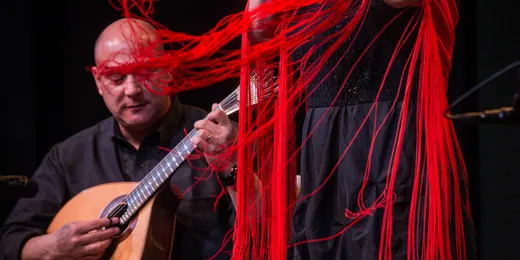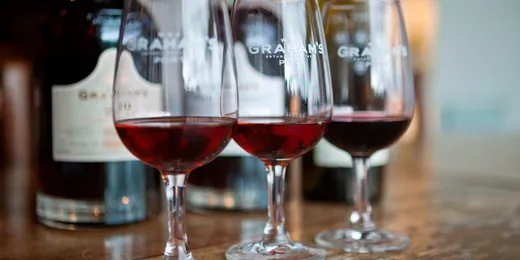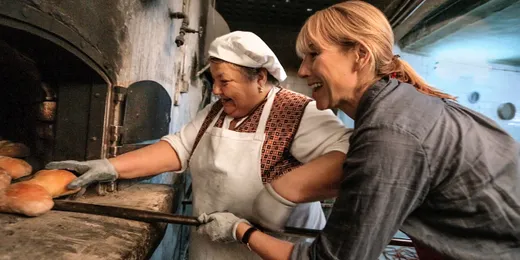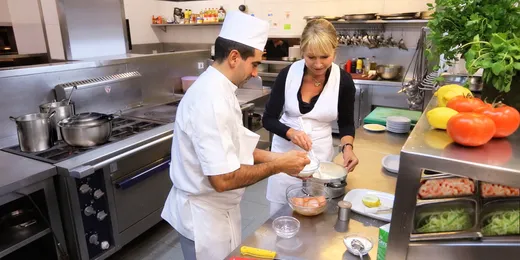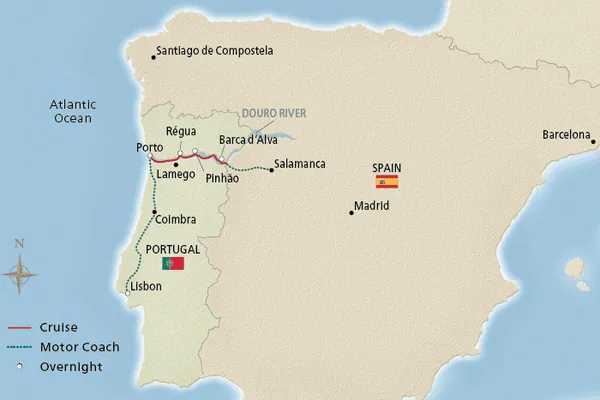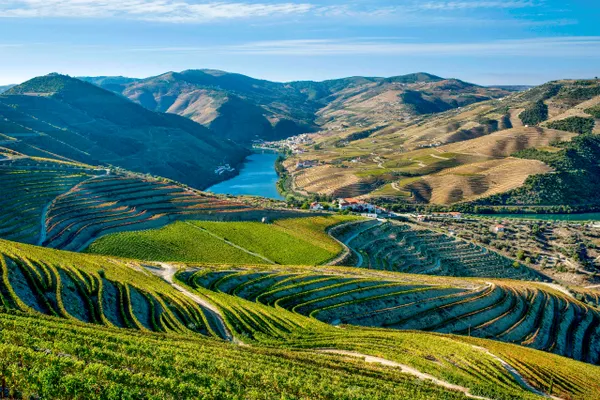
Discover Portugal
Experience Portugal’s picturesque landscapes and diverse cultural treasures. From Porto’s cobblestone streets to the Douro Valley’s scenic vineyards, this enchanting country offers visitors a variety of delights. Read on to learn more about a hearty local sandwich, enhance your knowledge of fado music and delve into the lives of two notable Portuguese explorers.

Portugal
Portugal lies along the Atlantic coast and occupies one-sixth of the Iberian Peninsula, as well as two island groups in the Atlantic: the Azores and Madeira Islands. While it is not a large country, Portugal contains a great deal of geographical diversity, from low-lying plains to the towering Estrela Mountains. Its northern coast and mountainous interior tend to be sparsely settled, while the warm, fertile south is more populous. Temperatures average about 75°F (24°C) in summer and 50°F (10°C) in winter, although the weather can be cooler at higher elevations.
Lisbon, Portugal’s capital city, was settled roughly four centuries before Rome and is the second-oldest European capital after Athens, Greece. The country has had the same defined borders since 1249, making it one of the oldest countries in Europe. Once a great world power, Portugal’s legacy can still be traced through linguistic patterns. Beyond Portugal, Portuguese is also the official language of Angola, Brazil, Cape Verde, East Timo, Equatorial Guinea, Guinea-Bissau, Macao, Mozambique, and São Tomé and Príncipe. It is the sixth most spoken language on Earth.
Portugal is home to more than 15 UNESCO World Heritage Sites, including the Douro wine region, which is known for its famous port wine. Much loved for its characteristic full-bodied sweetness, port has been produced in the area for more than 300 years. According to the guidelines established by the European Union’s Protected Designation of Origin, only wine produced in the Douro Valley may be labeled “port” or “porto” (although this is not required in the US).
In 1994, Lisbon was designated a European City of Culture, and it hosted the World’s Fair in 1998. The latter event catalyzed the city’s largest renewal project since the rebuilding in the wake of the 1755 earthquake, including the construction of Europe’s longest bridge: the Vasco de Gama Bridge in Lisbon, which spans 10.5 mi. (17.2 km).

-
Cuisine—The must-have Portuguese sandwich
The francesinha is a rich, savory sandwich that has moved beyond its humble origins in Porto to become a nationwide staple. Even though the name francesinha means “little Frenchie,” there is nothing little and hardly anything French about this robust meal.
The idea for the sandwich is credited to a Porto native named Daniel da Silva, who immigrated to France in the 1960s. Upon his return to Portugal’s Alentejo region, he tried to modify the classic French croque monsieur (an open-faced ham, cheese and egg sandwich) for Portuguese tastes. It was not a smashing success, but when da Silva returned to his native Porto, he developed a heartier version.
The now-classic francesinha begins with thickly sliced bread layered with fried pork belly or bacon, smoked chorizo or linguiça sausage, roast pork slices and medium-rare beefsteak. The meat is then topped with a fried egg and cheese, and the assembled sandwich then gets slathered with a generous ladling of a sweet, salty and tangy sauce—a tomato- and beer-based concoction with a dash of Portuguese pepper sauce and a mixture of spices. Many eateries guard their francesinha sauce recipes like state secrets, but you can now buy various bottled varieties in Portuguese supermarkets.
Today, you can also find vegetarian versions or variations that include pastrami or tuna, codfish, shrimp or prawns. There is even a breadless option called a pica-pau, which means “woodpecker,” in which the meat is cut into bite-sized pieces that can be eaten with toothpicks.
-
Culture—Fado music
In early 19th-century Lisbon, fado emerged as a new music genre. Derived from the Latin word for fate (fatum), it was born out of the music and dance traditions of the marginalized Iberian and Afro-Brazilian populations residing in the city’s Alfama District. Fado was typically performed in taverns and cafés, poetically depicting the everyday struggles and passions of the working class through melancholy tunes and moving lyrics.
By the 1830s, fado had gained widespread acclaim. This rapid rise in its popularity is often credited to the famed fadista Maria Severa Onofriana. Her soulful odes resonated with her audience, and her signature dark shawl even inspired the ensemble worn by later fadistas. Since then, fado has secured its place as an emblem of Portugal, inscribed in 2011 on UNESCO’s Intangible Cultural Heritage List.
Today, fado is traditionally performed by one singer—male or female—accompanied by Portuguese stringed instruments such as the guitarra portuguesa (12-string guitar), viola (6-string guitar) or viola baixo (8-string bass guitar). The songs are sung with so much emotion, even those who do not speak Portuguese feel as though they understand every word. At a performance’s end, you are left with the distinct impression that you have caught a glimpse into the soul of the Portuguese people.
-
History—2 remarkable Portuguese explorers
During the 15th and 16th centuries, Portugal played an integral role in the Age of Discovery, a period in which Europeans sought new trade routes across the globe. While Portugal had many notable explorers, here are two of the most intrepid:
Bartolomeu Dias (1457–1500)
Almost nothing is known about the life of Bartolomeu Dias before 1487, except that he had a place at the court of João II, king of Portugal, and was a superintendent of the royal warehouses. In 1486, João appointed Dias to head an expedition to find a sea route to the Indian Ocean, and his two ships departed circa August 1487.In January 1488, Dias’s ships were rounding the southernmost tip of Africa when storms blew them away. Dias ordered a turn to the south, hoping southeasterly winds would keep his ships from being dashed on the notoriously rocky shoreline. His decision was risky, but it worked, and the crew found the much warmer waters of the Indian Ocean. When the mariners returned to Portugal, they were met by triumphant crowds, and João ordered that maps now display the name for Cabo das Tormentas (Cape of Storms) as Cabo da Boa Esperança, or Cape of Good Hope.
Vasco da Gama (1460–1524)
Explorer Vasco da Gama was born into a noble Portuguese family around 1460. When he was old enough, da Gama joined the navy, where he earned a reputation as a tough and fearless navigator. In July 1497, da Gama captained a team of four vessels and set off to find a direct trade route to India and the East.After several months at sea, he rounded the Cape of Good Hope and made his way up the eastern coast of Africa. In May 1496, he reached Calicut, India, where he and his crew were welcomed by the local Hindu ruler. They stayed for three months.
In August 1498, da Gama and his men took to the seas again to begin their journey home. His timing could not have been worse, as his departure coincided with a monsoon. By early 1499, several crew members had died of scurvy, and in an effort to economize his fleet, da Gama ordered one of his ships to be burned. The first ship in the fleet did not reach Portugal until July 1499. In all, da Gama’s journey covered almost 24,000 miles in roughly two years, and only 54 of the crew’s original 170 members survived.
Portugal Highlights
From Lisbon’s lively art scene and Porto’s historic city center to enchanting hilltop villages and world-famous wine estates, we invite you to immerse yourself in Portugal’s stunning scenery and rich cultural traditions. Here are some highlights you may experience during a visit to this remarkable country:
- The dramatic melodies of fado music
- Lisbon’s UNESCO-listed Jerónimos Monastery
- Tales of the legendary Age of Discovery
- The storied architecture of Porto, the “City of Bridges”
- Castelo Rodrigo, a charming 16th-century village
- The idyllic terraced vineyards of the Douro Valley
- A port tasting in the heart of Portuguese wine country
- The sacred pilgrimage town of Lamego
Destination Insight Videos
-
Fado, Music of Portugal (2:36)
Learn about the dramatic songs of fado, born along Portugal’s waterfront. This music of passion often depicted the longing of women waiting for their men to return from sea.
-
History of Port Wines (3:58)
Take a journey with Karine as she explores Portugal’s history of wine and gains insight into its production and the various types of port, with a local expert on hand.
-
Cooking with Karine: Bread in Portugal (1:57)
Dona Manuela's family has been making their famous bread for centuries. Join Karine Hagen as Manuela teaches her how to make her delicious bread and learn how the bakery even helps the environment.
-
Portuguese Crème Brûlée (3:07)
Go behind the scenes with Karine to see how easy it is to make this local variation of everyone’s favorite dessert. You may want to take notes during this hands-on demonstration!
Portugal Travel FAQ
All-Inclusive Itineraries—Portugal
Choose one of our enriching, all-inclusive voyages and discover the many benefits of exploring in Viking comfort.



